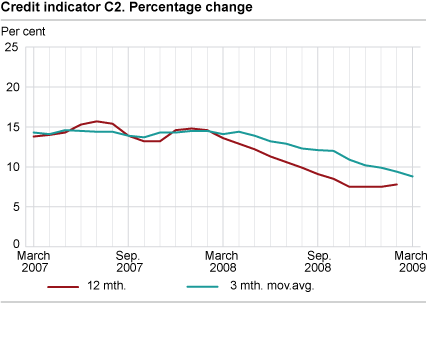Content
Published:
This is an archived release.
Substantial fall in enterprise debt growth
The twelve-month growth in the credit indicator C2 was 8.8 per cent to end-March, down from 9.4 per cent to end-February. Non-financial enterprises in particular contributed to the decrease in the C2 growth.
Non-financial enterprises’ gross domestic debt amounted to NOK 1 212 billion at end-March. The twelve-month growth to end-March was 11.2 per cent, down from 13.2 per cent in the previous month. Annualised one-month growth for March was -2 per cent. This was the lowest one-month growth since March 2004.
Converted to annual growth rate, the non-financial gross debt for the period January-March increased by 7.6 per cent compared with the three previous months. One month earlier this growth rate was 9.2 per cent. The fact that the growth based on the three-month moving average is lower than the twelve-month growth indicates that the twelve-month growth will continue to fall.
Unchanged growth in household debt
Household gross domestic debt totalled NOK 1 894 billion at end-March. The twelve-month growth was 6.7 per cent, which was unchanged from the previous month. This was the lowest twelve-month growth since August 1999.
Contributing factors to the high growth rates
The changed economic prospects have contributed to a dampening of the demand for new loans during recent months. In addition, the financial crisis has led to a sharpening of the financial corporations’ credit practice. In the long term, this will contribute to a reduction in the debt growth rates. In the evaluation of the growth rates in relation to C2, however, it should be noted that when an investment decision has been taken and a possible loan commitment is given there will always be a certain delay before this is included in actual debt data. It is not unlikely that in a situation with tight liquidity, customers draw on their credit lines to a greater extent than before, which also contributes to high debt figures.
Growth rates affected by the financial crisis
The general public’s gross domestic debt C2 amounted to NOK 3 345 billion at end-March, of which almost two thirds consisted of bank loans. The twelve-month growth in bank loans decreased from -0.2 per cent to end-February to -1.5 per cent to end-March, while the twelve-month growth in credit from mortgage companies increased from 63.2 per cent to 64.7 per cent in the same period.
The growth rates are affected by transfers of loans from banks to mortgage companies. This is due to the new legislation on covered bonds. The growth rate for banks and mortgage companies in total was 8.5 per cent to end-March, compared to 9.3 per cent the previous month.
The twelve-month growth rate in bond debt continued to rise from 5.1 per cent to end-February to 9.1 per cent to end-March. This was the highest twelve-month growth since August 2007. The growth rate in certificate debt went up from 53 per cent to end-February to 55.4 per cent to end-March.
| October 2008 | November 2008 | December 2008 | January 2009 | February 2009 | March 2009 | ||||||||||||||||||||||||||||||||||
|---|---|---|---|---|---|---|---|---|---|---|---|---|---|---|---|---|---|---|---|---|---|---|---|---|---|---|---|---|---|---|---|---|---|---|---|---|---|---|---|
| 12 mth. total | 12.0 | 10.9 | 10.2 | 9.9 | 9.4 | 8.8 | |||||||||||||||||||||||||||||||||
| 3 mth. moving average total | 8.5 | 7.5 | 7.5 | 7.5 | 7.8 | ||||||||||||||||||||||||||||||||||
| 12 mth. households | 8.2 | 7.4 | 7.2 | 6.8 | 6.7 | 6.7 | |||||||||||||||||||||||||||||||||
| 12 mth. non-financial enterprises | 19.1 | 17.4 | 15.2 | 14.6 | 13.2 | 11.2 | |||||||||||||||||||||||||||||||||
|
C2 is an approximate measure of the size of the gross domestic debt of the general public (households, non-financial enterprises and municipalities) in NOK and foreign currency. Statistics Norway also compiles the credit indicator C3, which in addition to C2 (the public’s domestic gross debt) also includes the public’s external loan debt. Most of the public’s external loan debt refers to non-financial enterprises. The C3 statistics are published approximately one month later than the C2. |
The statistics is now published as Credit indicator.
Contact
-
Statistics Norway's Information Centre
E-mail: informasjon@ssb.no
tel.: (+47) 21 09 46 42

